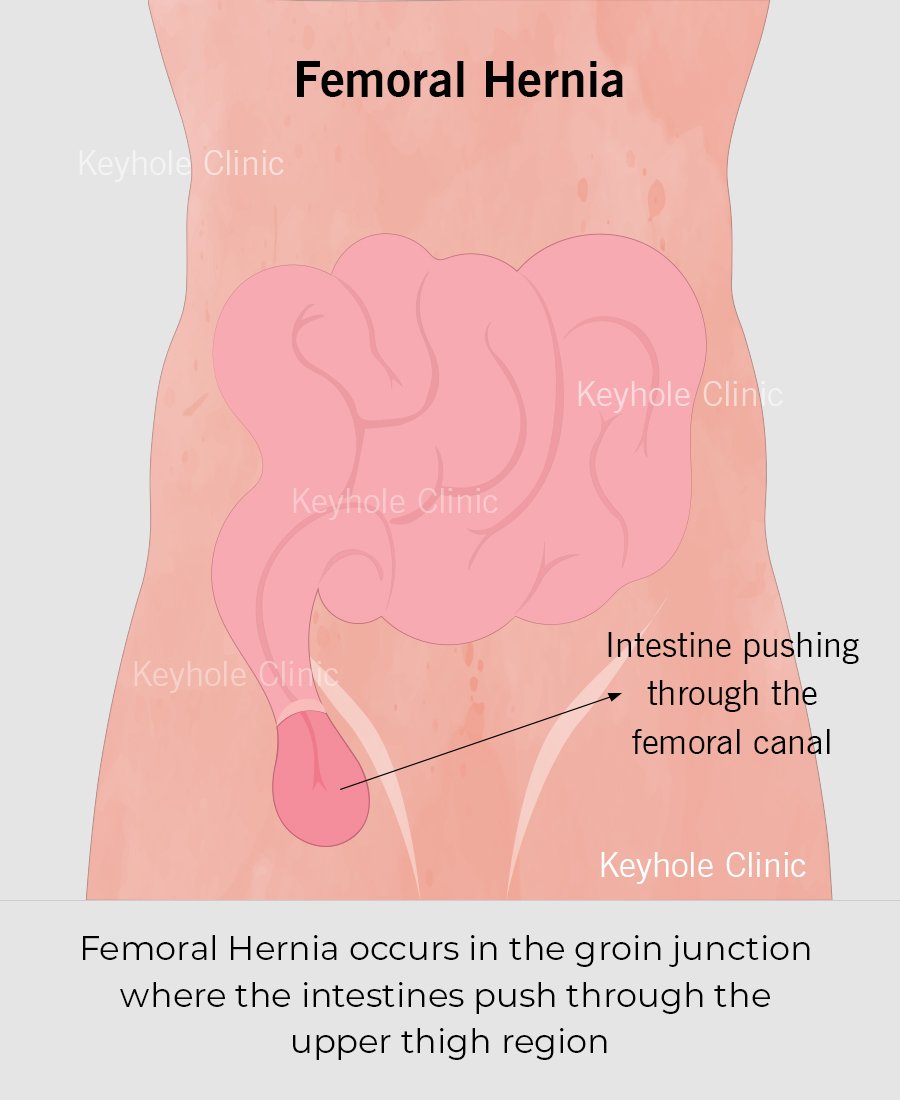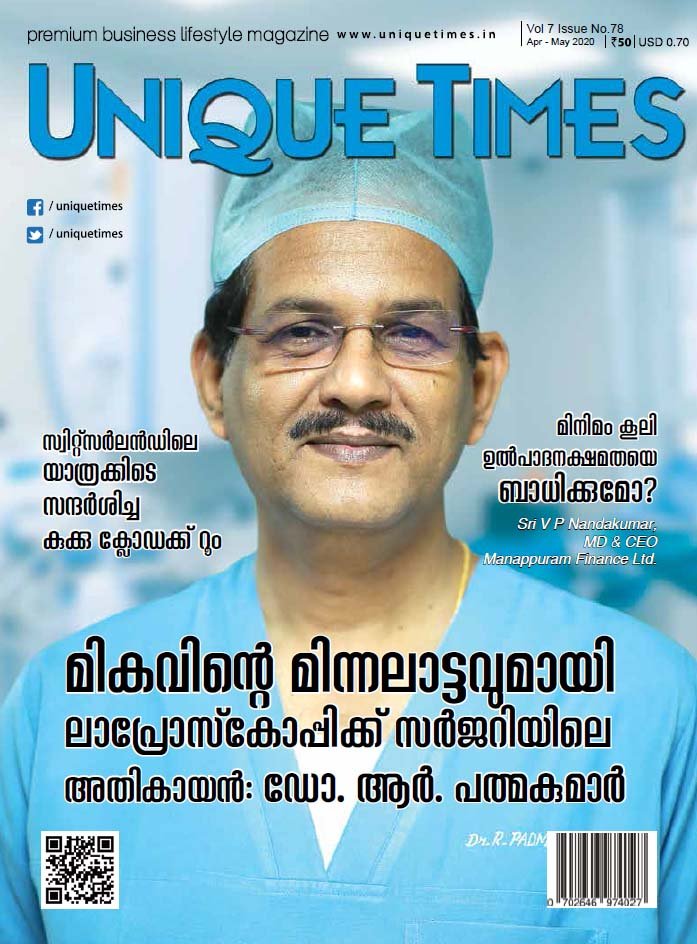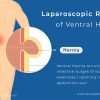Femoral Hernia
A femoral hernia occurs in the groin junction when the tissues in the lower abdomen push through the upper thigh region. Femoral hernia is common in women as the pelvis region is wider in women when compared to men. Femoral canal contain the ligaments and functions to hold and support the uterus in position.

Symptoms of Femoral Hernia
- Sudden groin and abdominal pain
- Nausea
- Vomiting
Diagnosing Femoral Hernia
Femoral hernia causes pain in the abdominal area. The doctor suggests various tests to diagnose its presence including ultrasound scan or CT scan. The hernia can get complicated when they gets strangulated or obstructed causing extreme pain while lifting heavy objects or during bowel movements.
- Hernia obstruction –The bulged tissues gets stuck in the femoral canal resulting in excessive pain, nausea and vomiting.
- Hernia strangulation –The strangulated hernia causes restriction of blood flow to the area and gets trapped in the femoral canal. The condition requires emergency surgery to restore the blood supply to the area.
Causes
There are many factors that lead to the formation including:
- excess strain during bowel movement
- constipation
- heavy weight lifting
- obesity
- Chronic cough
Treatment
The surgery is initiated by administering a dose of anesthesia to relax the patient and to reduce the pain and discomfort caused by the condition. The surgeon makes a small incision in the abdominal wall and inserts a laparoscope to view the internal abdominal cavity and associated organs. A laparoscope is a thin long tube that has a camera attached to its end and enables the surgeon to view enlarged images of the cavity and the organs with a monitor attached. After investigation, the surgeon makes few more incisions to insert hernia repair tools and the bulged tissues are pushed back and placed in position. Later a mesh is placed in the femoral canal to prevent the possibility of reoccurrence of hernia in the canal. Later the incisions are closed and sutured. The surgery takes around 45 minutes to one hour to complete. After the surgery, meditations are administrated to reduce pain and discomfort from the surgery. The patient can leave the hospital in a day or two and are instructed not to do any heavy tasks like weight lifting. Diet rich in fiber content and adequate fluid intakes is instructed. The laparoscopic surgery has several advantages with a faster recovery time and minimal scars.
Femoral Hernia vs Inguinal Hernia
Both Femoral Hernia and Inguinal Hernia occurs at the groin area. However, there are key differences in both these hernias.
| Inguinal Hernia | Femoral Hernia |
|---|---|
| Inguinal hernia is located near the pubic bone | Femoral hernia is located near the upper thigh. |
| More common in Men | Femoral Hernia is more common in women. |
| Inguinal Hernias are more frequent compared to femoral hernia | Femoral hernia is less frequent compared to inguinal Hernia |
Compared to Inguinal hernia, femoral hernias carry a higher risk of leading to strangulation. Strangulation in hernia is life threatening as it cut off the supply of blood.
Other types of hernia
- Inguinal hernia
- Hiatal hernia
- Ventral Hernia
- Obturator Hernia
- Umbilical hernia
- Incisional hernia
Hiatal Hernia
Hiatus hernia develops when the upper part of the stomach bulges through an opening in the diaphragm. The stomach pushes through the opening in the diaphragm and bulges into the chest.
Inguinal Hernia
Inguinal hernia is a condition that occurs when abdominal tissues, such as part of the intestine, protrudes through a weak spot of the inguinal canal.
Ventral Hernia
Ventral Hernia can occur in any location of the abdominal wall as a bulge of abdominal tissues through a weak opening in the abdominal wall muscles. When the intestinal tissue gets caught up in the bulge and cannot be pushed back it is called Stangulaged Ventral Hernia.
Obturator Hernia
Obturator Hernia is a very rare type of hernia that occurs through an opening in the pelvis. The intestine bulges through the obturator foramen.
Umbilical Hernia
Umbilical hernia occurs at the belly button (umbilicus). A loop of intestine pushes through the umbilical ring. in the groin junction when the tissues in the lower abdomen push through the upper thigh region.
Incisional Hernia
Incisional hernia occurs at the location of a previous surgical incision.
About Dr. R. Padmakumar
Dr. R. Padmakumar is one of the Best Hernia Surgeon in India. He has been changing lives through Keyhole Surgery. He has got more than 30 years of hands-on experience in laparoscopic Surgery in major hospitals across India and has completed more than 7000 cases of Laparoscopic Hernia Surgeries. Dr. Padmakumar has trained more than 300 surgeons from all over the world the art of laparoscopic surgery especially Laparoscopic Hernia Surgery. Dr. Padmakumar is also hailed as one of the Best Bariatric Surgeon in India & UAE. He is renowned for new and improved treatment techniques and the first in the World to perform Scarless Bariatric Surgery with Tummy Tuck / Abdominoplasty. He is also one of the very few thyroid surgeons in India doing Endoscopic Thyroidectomy (scarless thyroid surgery).


-
Anal Fissure Treatment
-
Gynaecomastia Treatment
- Piles / Hemorrhoids Treatment
- Varicose Veins Treatment
- Laser Treatment for Varicose Veins
- Diabetic Foot Treatment







